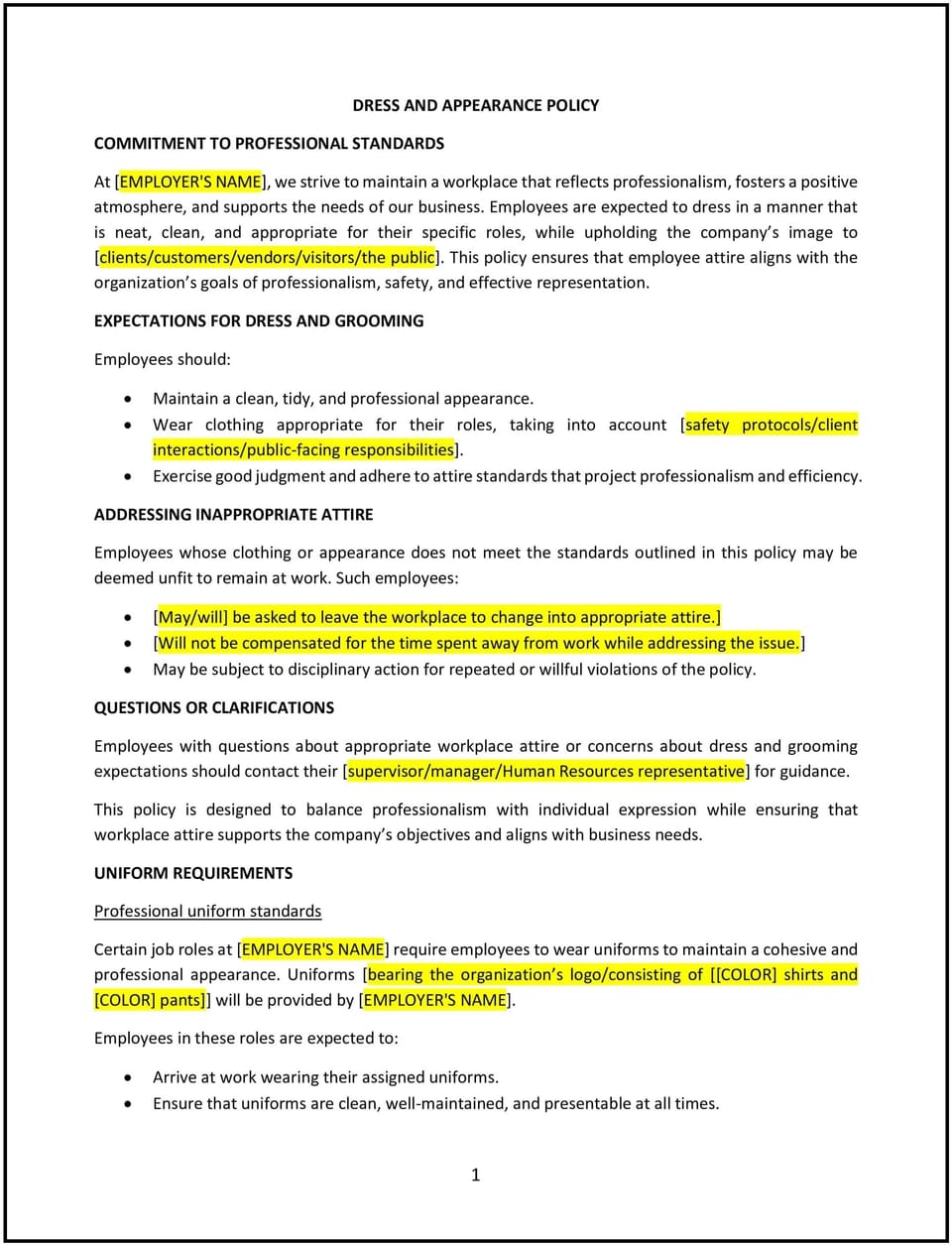Dress and appearance policy (Alaska): Free template

Dress and appearance policy (Alaska)
In Alaska, a dress and appearance policy establishes guidelines for employee attire to promote professionalism, safety, and inclusivity while considering the unique environmental and cultural factors in the state. This policy ensures employees understand workplace expectations and provides clarity on acceptable attire for various roles or work conditions. By implementing this policy, businesses can maintain a cohesive image and accommodate diverse work environments, including outdoor, remote, and office settings.
Alaska’s climate and industries, such as oil, gas, and tourism, may require tailoring the policy to address practical needs like weather-appropriate clothing or safety gear.
How to use this dress and appearance policy (Alaska)
- Define standards: Specify acceptable attire for different roles or settings, such as formal office wear, business casual, or industry-specific uniforms.
- Address safety requirements: Include provisions for safety gear or protective clothing required in roles involving hazardous conditions or outdoor work.
- Accommodate local factors: Account for Alaska’s weather conditions and cultural diversity, allowing employees flexibility to wear climate-appropriate or culturally significant attire.
- Outline exceptions: Provide guidance on accommodations for medical, religious, or cultural reasons, ensuring inclusivity and compliance with anti-discrimination laws.
- Communicate expectations: Share the policy during onboarding and reinforce it through regular communication, ensuring employees understand and follow the guidelines.
Benefits of using a dress and appearance policy (Alaska)
A dress and appearance policy offers several advantages for businesses in Alaska. Here’s how it helps:
- Promotes professionalism: Ensures employees represent the company appropriately in front of clients, customers, and stakeholders.
- Enhances safety: Addresses safety concerns by requiring appropriate gear for hazardous or outdoor work environments.
- Supports inclusivity: Accommodates cultural, religious, and personal preferences while maintaining professional standards.
- Improves consistency: Sets clear expectations across the organization, reducing confusion or conflicts about appropriate attire.
- Reflects company values: Aligns employee appearance with the company’s brand and mission, fostering a cohesive and professional image.
Tips for using a dress and appearance policy (Alaska)
- Adapt for remote work: Include guidelines for virtual meetings, such as maintaining a professional appearance when representing the company online.
- Be weather-aware: Address Alaska’s extreme weather conditions by allowing for layering, insulated clothing, or other practical attire.
- Involve employees: Gather feedback from employees on what works best for their roles and work environments to ensure the policy is practical and fair.
- Balance flexibility and consistency: While maintaining a professional standard, allow for some flexibility to accommodate diverse needs and preferences.
- Review regularly: Update the policy as needed to reflect changes in workplace practices, roles, or employee feedback.
Q: How should I determine acceptable attire for different roles?
A: Base attire guidelines on the nature of the role, level of customer interaction, and any safety requirements, ensuring they align with the company’s values and brand.
Q: How can the policy accommodate Alaska’s weather conditions?
A: Include provisions for climate-appropriate clothing, such as insulated boots, jackets, and layering, particularly for outdoor roles or travel in remote areas.
Q: What accommodations should be included for cultural or religious attire?
A: Ensure the policy allows for culturally or religiously significant clothing, as long as it aligns with safety and professional standards.
Q: How can I enforce this policy fairly?
A: Apply the policy consistently across all employees, clearly communicate expectations, and handle violations with a focus on education and fairness.
Q: How often should this policy be reviewed?
A: The policy should be reviewed annually or whenever significant changes occur in workplace roles, regulations, or employee feedback.
This article contains general legal information and does not contain legal advice. Cobrief is not a law firm or a substitute for an attorney or law firm. The law is complex and changes often. For legal advice, please ask a lawyer.


